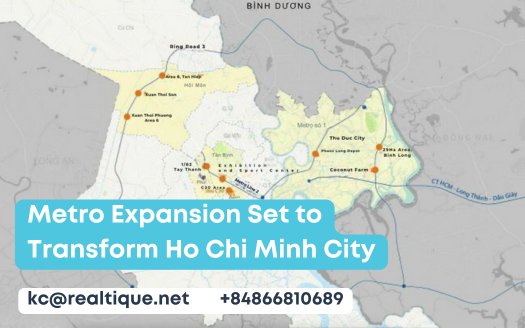Metro Expansion Set to Transform Ho Chi Minh City
The impending expansion of the metro system in Ho Chi Minh City represents a significant shift in urban mobility and infrastructural development. With Metro Line 1 nearing completion and the initiation of Metro Line 2 set for 2025, the implications for traffic reduction and sustainable urban planning are substantial. This change is further supported by strategically designated transit-oriented development (TOD) sites, which promise to enhance connectivity and quality of life. However, the intricacies surrounding government regulations and the timeline for these developments raise critical questions about their long-term impact on the city’s growth.
Table of Contents
Overview of Metro Development
The metro development in Ho Chi Minh City is set to revolutionize urban mobility and enhance connectivity across the city and surrounding regions.
The city is undertaking an ambitious plan to develop 11 metro lines, with Metro Line 1 (Ben Thanh – Suoi Tien) expected to complete by the end of the current year, connecting to Thu Duc City.
Metro Line 2 (Ben Thanh – Tham Luong) is scheduled to commence construction in 2025.
Additionally, the planned Ring Road 3 aims to link four provinces, further improving regional accessibility.
The successful implementation of these metro lines will significantly alleviate traffic congestion, reduce travel times, and promote sustainable urban development, ultimately converting Ho Chi Minh City into a more integrated and accessible metropolis.
Understanding Transit-Oriented Development
Transit-oriented development (TOD) represents a strategic approach to urban planning that prioritizes accessibility and efficiency in public transportation systems.
By concentrating residential and commercial spaces around transit hubs, TOD seeks to maximize land use and reduce reliance on personal vehicles. This model nurtures high-density areas, generating increased demand for transportation services while promoting sustainable urban growth.
Successful examples from countries like Japan, South Korea, and Singapore illustrate the potential benefits of TOD, including enhanced mobility and reduced traffic congestion.
Although Vietnam’s current implementation of TOD remains limited, the concept offers a structure for future developments that integrate transport infrastructure with surrounding communities, ultimately enhancing the quality of urban life in rapidly growing cities like Ho Chi Minh City.
Identified TOD Sites in TP HCM
Identifying key locations for transit-oriented development (TOD) in Ho Chi Minh City is essential for enhancing urban connectivity and optimizing land use.
Nine TOD sites have been earmarked around major metro projects to facilitate efficient public transport access and encourage urban growth. The largest site, spanning 389 hectares in Xuan Thoi Thuong, Hoc Mon, is ready for significant development, while a smaller 5.1-hectare site in Tan Binh District will also support TOD initiatives.
Additional opportunities for TOD are emerging in Tan Hiep Commune and near Tan Kien Station. These locations strategically align with existing transportation routes and infrastructure, promoting high-density living and commercial activities that can stimulate the local economy and improve residents’ quality of life.
Government Regulations for Implementation
As local authorities prepare for the implementation of transit-oriented development (TOD) in Ho Chi Minh City, it is essential to establish clear boundaries and legal structures that will guide the process.
This involves assessing land use and determining specific conditions necessary for effective TOD implementation. Prioritization will focus on areas that exhibit the greatest potential for new developments or enhancements, ensuring efficient use of resources and infrastructure.
Additionally, existing urban planning regulations will be considered to maintain cohesion and compliance within the city’s structure. Local authorities aim to finalize these adjustments and regulations by 2025, providing a strong foundation for the expansion of TOD.
This strategic approach will facilitate a seamless integration of transport hubs with surrounding residential and commercial zones.
Timeline for Future Developments
In the coming years, Ho Chi Minh City is set to commence a series of significant developments aimed at enhancing urban connectivity and infrastructure. Key projects include Metro Lines 1 and 2, as well as the ambitious Ring Road 3. The timeline for these developments is critical to achieving the city’s long-term growth objectives.
| Year | Development |
|---|---|
| 2024 | Completion of Metro Line 1 |
| 2025 | Construction begins for Metro Line 2 |
| 2026 | Expected completion of Ring Road 3 |
| 2026-2028 | Development of additional TOD areas |
| Ongoing | Evaluation of urban renewal potential |
These initiatives are designed to facilitate improved transportation networks and support urban renewal efforts, ultimately altering the urban environment.





